The first electric tramline in Porto was opened in 1895. Until 1946 the network was operated by the CCFP: Companhia Carris de Ferro do Porto. This was a private company. In 1946 the operations were taken over by the municipal owned STCP: Serviço de Transportes Colectivos do Porto (now Sociedade de Transportes Colectivos do Porto)
On this page an overview of the network development since the STCP took over in 1946.
STCP made a number of improvements to the network. A new route was opened in 1947 to Pereiró and the route between Constituição and Boavista was opened in 1949. In Coimbrões, Leça da Palmeira and Ermesinde turning loops were made. These turning loops ended the necessity to shunt with trailers. In the 1950’s single track sections of the lines 6, 7, 10 and 15 got double track. For the lines 6 and 15 this meant their routes became double track over the whole length.
The ever increasing number of private cars together with the increasing number of trams caused severe problems on Praça da Liberdade, still the hub of the system where most tram services terminated. To solve this new termini were made at Carmo, Bolhão and Batalha where part of the trams would terminate instead of going to Praça. These new termini were made as loops, also because of the introduction of one way streets in the city centre. As a result a large part of the track layout in the centre was significant changed in the late 1940’s. The setup of the tram services was altered to reduce the numbers of trams going to Praça.
With the layout changes of 1946 to 1948 part of the lines terminated until 21h at Batalha, Carmo or Bolhão and after 21h on Praça da Liberdade. Also a number of lines were created to reinforce the busiest parts of existing lines. The resulting network as it came into existence until 1951 and lasted until 1958 was rather complicated.
With omitting supplemental lines that were covered over their whole length by the “main” line, the lines after the changes made by the STCP between 1946 and 1951 were:
1 Praça da Liberdade – Infante – Massarelos – Foz (Castelo) – Castelo do Queijo – Matosinhos (Brito Capelo) – Leça da Palmeira.
2, 2/, 2//, 18, 18/ & 18// Praça da Liberdade – Carmo – Massarelos – Foz – Castelo do Queijo – Boavista – Carvalhosa / Palácio – Carmo – Praça da Liberdade. All route 2 trams had their terminus at Carmo, all route 18 trams on Praça. The route 2/ and 18/ cars ran via Carvalhosa, the route 2// and 18// cars ran via Palácio. During the trip the trams changed the line number. This could be from 2 or 18 to all four different “dashed” lines and v.v.
3 Praça da Liberdade – Carmo – Palácio – Lordelo.
4 & 4/ Praça da Liberdade – Carmo – Carvalhosa / Palácio – Boavista – Pereiró. (Trams via Palácio had the indication 4/ and did not operate after 21h) These lines were curtailed from Alfândega to Praça and in 1947 extended from Fonte da Moura to Pereiró.
5 Carmo – Carvalhosa – Boavista – Fonte da Moura – Castelo do Queijo – Matosinhos (Brito Capelo) – Leça da Palmeira (Castelo). After 21h terminus on Praça da Liberdade.
19 Praça da Liberdade – Carmo – Palácio – Boavista – Fonte da Moura – Castelo do Queijo – Matosinhos (Brito Capelo) – Leça da Palmeira (Castelo).
6 Carmo – Carvalhosa – Carvalhido – Monte dos Burgos. After 21h terminus on Praça da Liberdade.
6/ Praça da Liberdade – Carmo – Carvalhosa – Carvalhido. Not operating after 21h.
7 Carmo – Praça da República – Rua de Vale Formoso – Amial – São Mamede – Ponte da Pedra. After 21h terminus on Praça da Liberdade.
7/ Praça da Liberdade – Carmo – Praça da República – Rua de Vale Formoso – Amial. Not operating after 21h.
7// Batalha – Bolhão – Gonçalo Cristóvão – Praça da República – Rua de Vale Formoso – Amial – São Mamede. Not operating after 21h.
8 Praça da Liberdade – Carmo – Praça da República – Rua de Vale Formoso – Paranhos (Campo Lindo).
9 Bolhão – Praça Marquês de Pombal – Rua Costa Cabral – Areosa – Águas Santas – Ermesinde. After 21h terminus on Praça da Liberdade.
9/ Praça da Liberdade – Bolhão – Praça Marquês de Pombal – Rua Costa Cabral – Areosa.
9// Batalha – Bolhão – Praça Marquês de Pombal – Rua Costa Cabral – Areosa – Águas Santas – Ermesinde. Not operating after 21h. On Batalha trams changed from line 14/ to line 9// v.v. On the lines 9 and 9/ mainly bogie cars were used, on line 9//+14/ 2-axle cars with trailers.
10 Bolhão – Bonfim – São Roque – Venda Nova. After 21h terminus on Praça da Liberdade.
10/ Bolhão – Bonfim – São Roque – Santa Eulália – São Pedro da Cova. After 21h terminus on Praça da Liberdade.
10// Bolhão – Bonfim – São Roque – Santa Eulália – Gondomar (Souto). After 21h terminus on Praça da Liberdade.
10E Praça da Liberdade – Bolhão – Bonfim – São Roque. Not operating after 21h.
11 Praça da Liberdade – Batalha (opposite direction Bolhão) – São Lazaro – Bonfim – Campanhã.
12 Batalha – São Lazaro – Heroismo – Campanhã. After 21h terminus on Praça da Liberdade.
13 Batalha – Ponte Luiz I – Santo Ovidio. After 21h terminus on Praça da Liberdade.
14 Praça da Liberdade – Batalha – Ponte Luiz I – Devesas – Arco do Prado – Coimbrões.
14/ Batalha – Ponte Luiz I – Devesas – Arco do Prado – Coimbrões. On Batalha trams changed from line 14/ to line 9// v.v.
15 Praça da Liberdade – Batalha – Bonfim – Antas – Rua Costa Cabral – Praça Marquês de Pombal – Bolhão – Praça da Liberdade. One way only.
15/ Praça da Liberdade – Bolhão – Praça Marquês de Pombal – Rua Costa Cabral – Antas – Bonfim – Bolhão – Praça da Liberdade. One way only.
15E Praça da Liberdade – Bolhão – Bonfim – Antas – Rua Costa Cabral – Praça Marquês de Pombal – Bolhão – Praça da Liberdade. One way only. Not operating after 21h.
16 Batalha – Bolhão – Gonçalo Cristóvão – Praça da República – Boavista – Bessa – Fonte da Moura – Castelo do Queijo – Matosinhos – Leça (Av.Antunes Guimarães near the fire brigades). ex line 17/
17 Batalha – Bolhão – Gonçalo Cristóvão – Praça da República – Boavista – Bessa – Fonte da Moura – Castelo do Queijo – Foz.
20, 20/, 21 & 21/ Praça da Liberdade – Batalha – São Lazaro – Rua Alegria – Rua da Constituição – Ramada Alta – Boavista – Palácio / Carvalhosa – Carmo – Praça da Liberdade. Lines 20 & 20/ via Palácio, lines 21 & 21/ via Carvalhosa, lines 20 & 21 counter clockwise, lines 20/ & 21/ clockwise, lines 21 & 21/ not operating after 21h.
In 1947 in the city centre two short lines were introduced, but both were suspended already two years later:
- AC Alfândega – Infante – Praça – Carmo
- BC Batalha – Praça – Carmo
Trams on the way down
The complete replacement of the trams by trolleybuses as was decided in the 1950’s evidently needed much time and in the end was never realised, the trolleybuses themselves disappeared in 1997. Replacement of trams by trolleybuses started on 1 January 1959 with the lines 3, 14 and 14/, a few months later followed by line 13 and on 3 March 1960 line 12. Line 11 was changed to a one way circular line:
11 Praça da Liberdade – Batalha – São Lazaro – Heroismo – Campanhã – Bonfim – Bolhão – Praça da Liberdade.
Line 4/ between Praça and Pereiró via Palácio was renumbered to 3.
The complex line group 2 & 18 was simplified. All trams to/from Restauração now terminated on Praça and all trams to/from Boavista terminated until 21h at Carmo and after 21h on Praça. With this change the line numbers 2// and 18/ disappeared.
On 4 March 1960 the route between Matosinhos and Leça da Palmeira was closed because of the extension of the Leixões docks. Leça da Palmeira was to be served by bus. The lines 1, 5, 16 and 19 were cut back to a new stub terminus next to the Mercado in Matosinhos. Shunting with trailers on a busy stub terminus wasn’t feasible, so this also meant the end of the trailer operations on the lines 1 and 5, leaving only line 9// with using trailers.
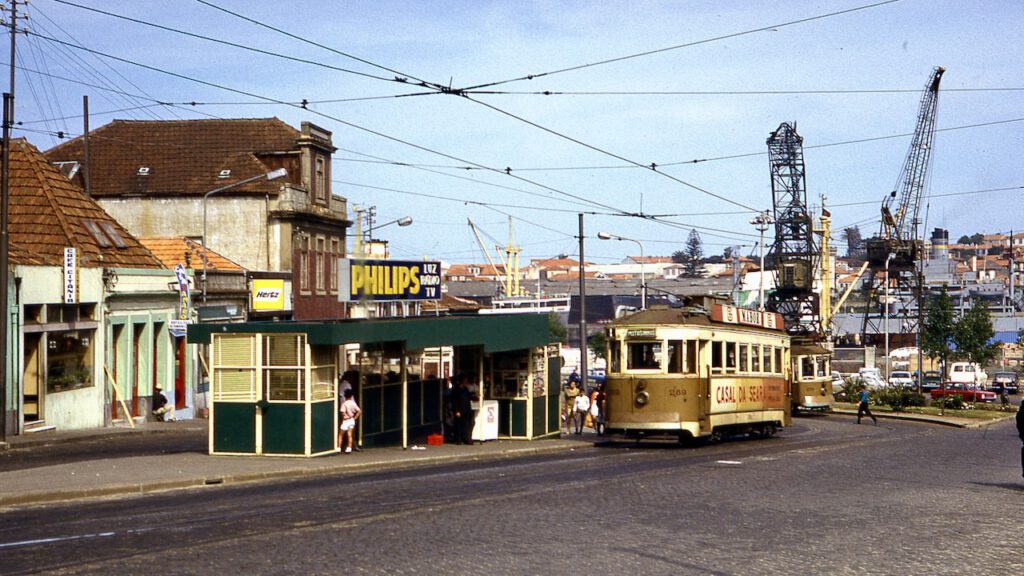
In a further attempt to reduce the congestion on Praça through working was introduced. Many trams to Praça didn’t terminate there anymore, but continued their trip on another line. Through working of trams from one route to another were: 1 with 9 and 9/, 6 with 15 and 15E, 3 and 4 with 15/, 8 with 11. This through workings made that line 6/ disappeared while the lines 6 and 9 were extended again during the whole day to Praça. Until 21h trams of line 1 arriving at Praça Almeida Garrett didn’t go into Praça da Liberdade but used a new laid track directly to Rua Sá da Bandeira to continue their trip as line 9 or 9/. Line 9// was cut back from Batalha to Bolhão.
Further closures during the 1960’s were:
- 10 June 1964 line 11 (replaced by trolleybuses)
- 1 January 1967 the line 10 group (temporary replaced by buses until the opening of the trolleybus lines 10, 11 &12 on 10 September 1967)
- 23 July 1967 the line 15 group (replaced by buses)
- 17 September 1967 the line 9 group (temporary replaced by buses until the opening of the trolleybus lines 9 & 29 in November 1968)
- 17 September 1967 the section of line 1 between Infante and Praça da Liberdade during daytime. After 21h this section was still used by the trams of line 1 until 17 November 1968 (replaced by buses)
- 20 July 1968 the line 20/21 group (replaced by buses)
For seven years the tram network remained unchanged, then again tramlines were replaced by buses:
- 6 October 1975 the line 7 group north of Arco d’Agua.
- 11 October 1976 line 6 north of Carvalhido.
- 29 November 1976 line 8 (no bus replacement).
- 9 May 1977 the remaining part of line 6.
- 20 June 1977 the remaining parts of the line 7 group.
- 31 October 1977 the part of the lines 16 and 17 between Batalha and Boavista. The remainder between Boavista and Matosinhos/Foz closed in 1978, but those routes were still served by the lines 18 and 19.
- 24 July 1978 the Carmo – Carvalhosa – Boavista route was suspended, which meant that the services of the lines 2, 4 and 5 were taken over by the lines via Palácio, 18, 3 and 19.
Buses replaced all tram services after about 21h and on Sundays since 1978.
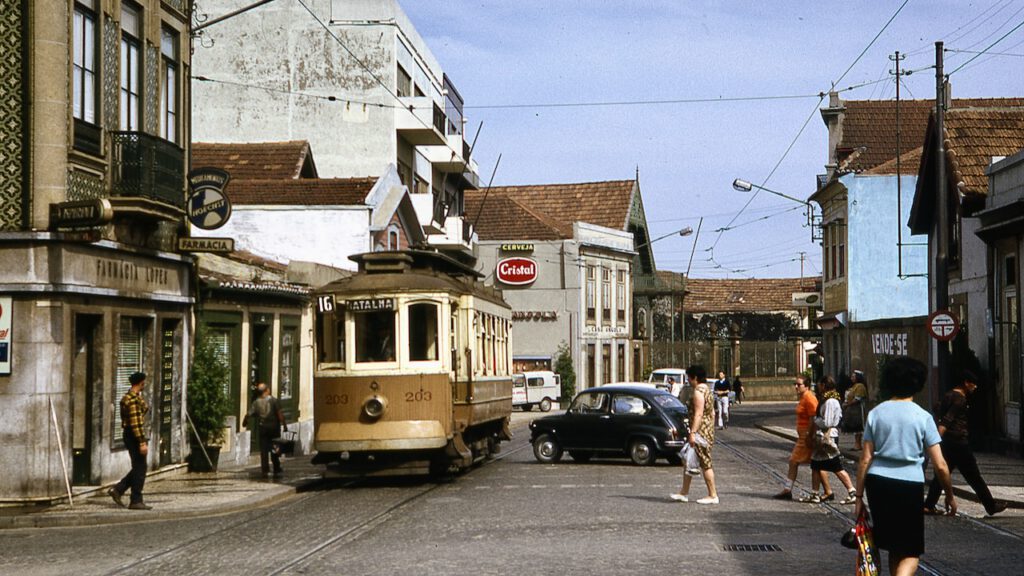
Due to a landslide near Viriato / Hospital de Sto.António the trams disappeared from Praça da Liberdade and between Carmo and Boavista on 6 February 1980. Line 18 couldn’t operate between Viriato and Carmo until 1981.
Line 3 to Pereiró was replaced by buses in 1984, leaving only the tramlines 1, 18 and 19.
STCP period maps
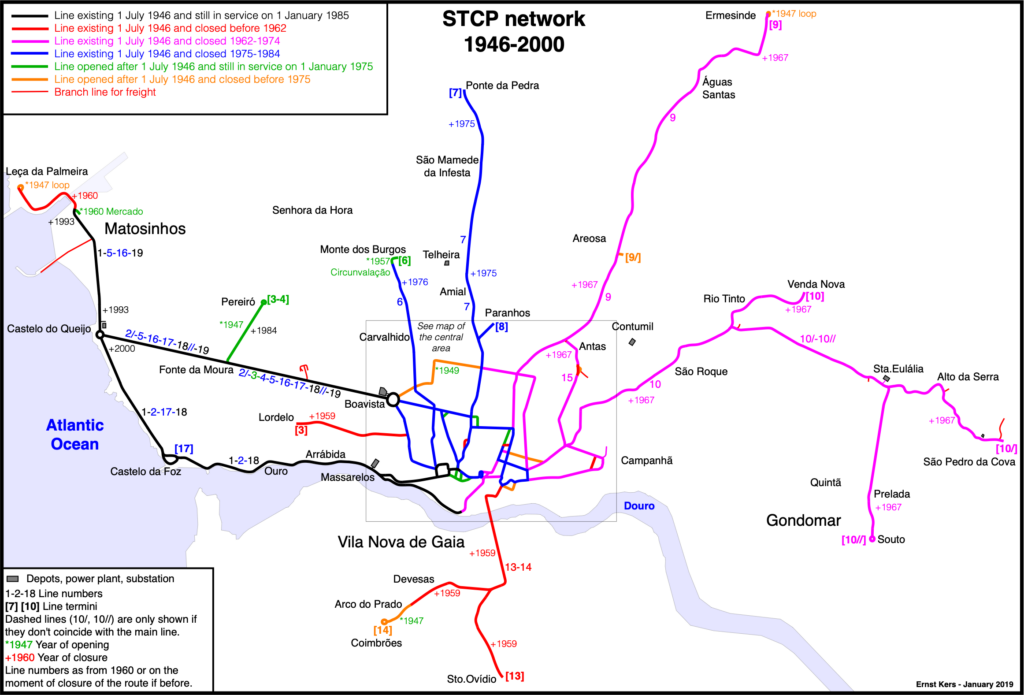
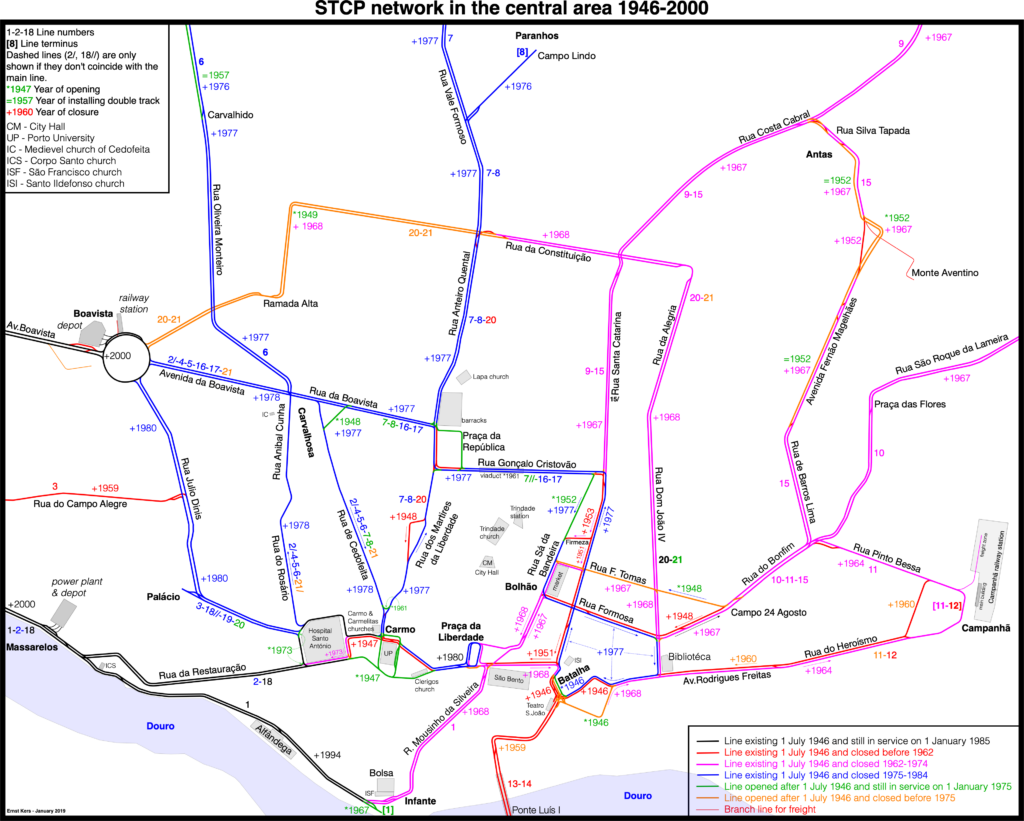
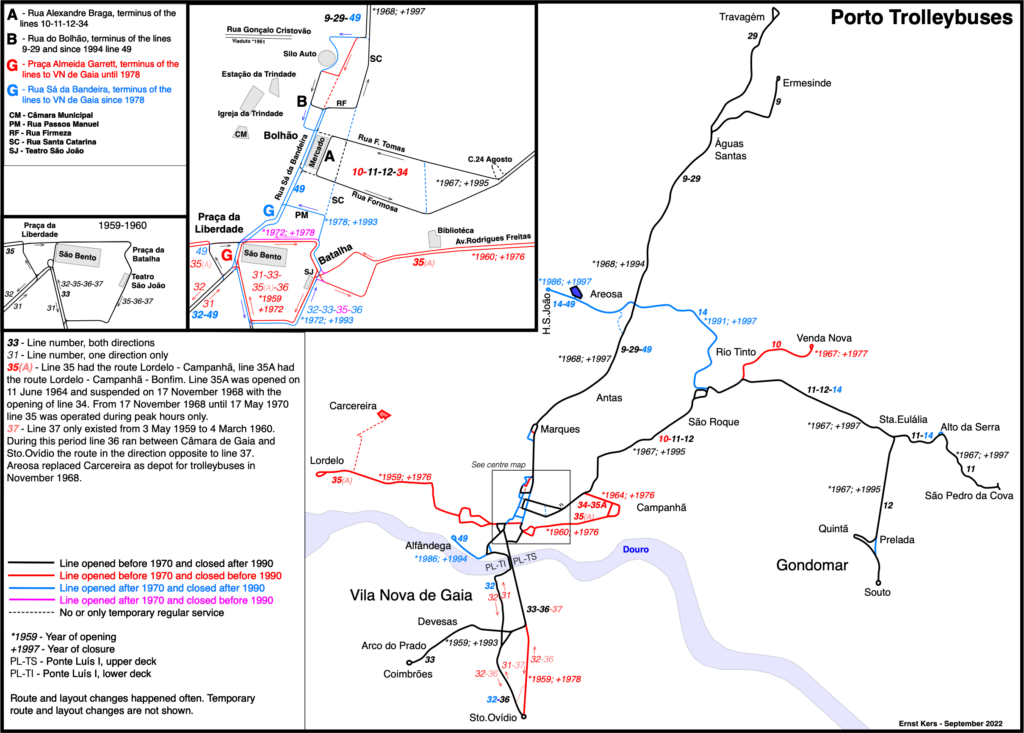
The classic tram evolves to heritage
On 11 September 1993 the route between Castelo do Queijo and Matosinhos was closed resulting in bus replacement for line 19 and curtailing line 1 to Infante – Castelo do Queijo. One year later, on 10 September 1994 the remainder of tramline 1 was replaced by buses, which continued again to Matosinhos and into the city centre.
Line 18 was the last remaining route of the classic Porto tram. Early 1995, 100 years after the first electric trams started to work, the final closure was announced. However instead of complete closure, the network was gradually changed into a heritage system. On 11 June 1996 a bus service with the line number 24 was introduced, following almost exactly the route of tramline 18. But tramline 18 survived, although frequencies decreased from every 15 minutes (with seven cars) to every 35 minutes (with three cars). At the positive side was that tram services were re-installed on Sundays.
Renovation and reconstruction of the involved streets and roads dictated the progress of the conversion of the network to the current heritage system. As a result many changes occurred between 1996 and 2007. Old electric trams on new tracks now ride along the classic route along the river (line 1), the first electric route in Rua da Restauração (line 18) and through the city centre between Carmo and Batalha (line 22).

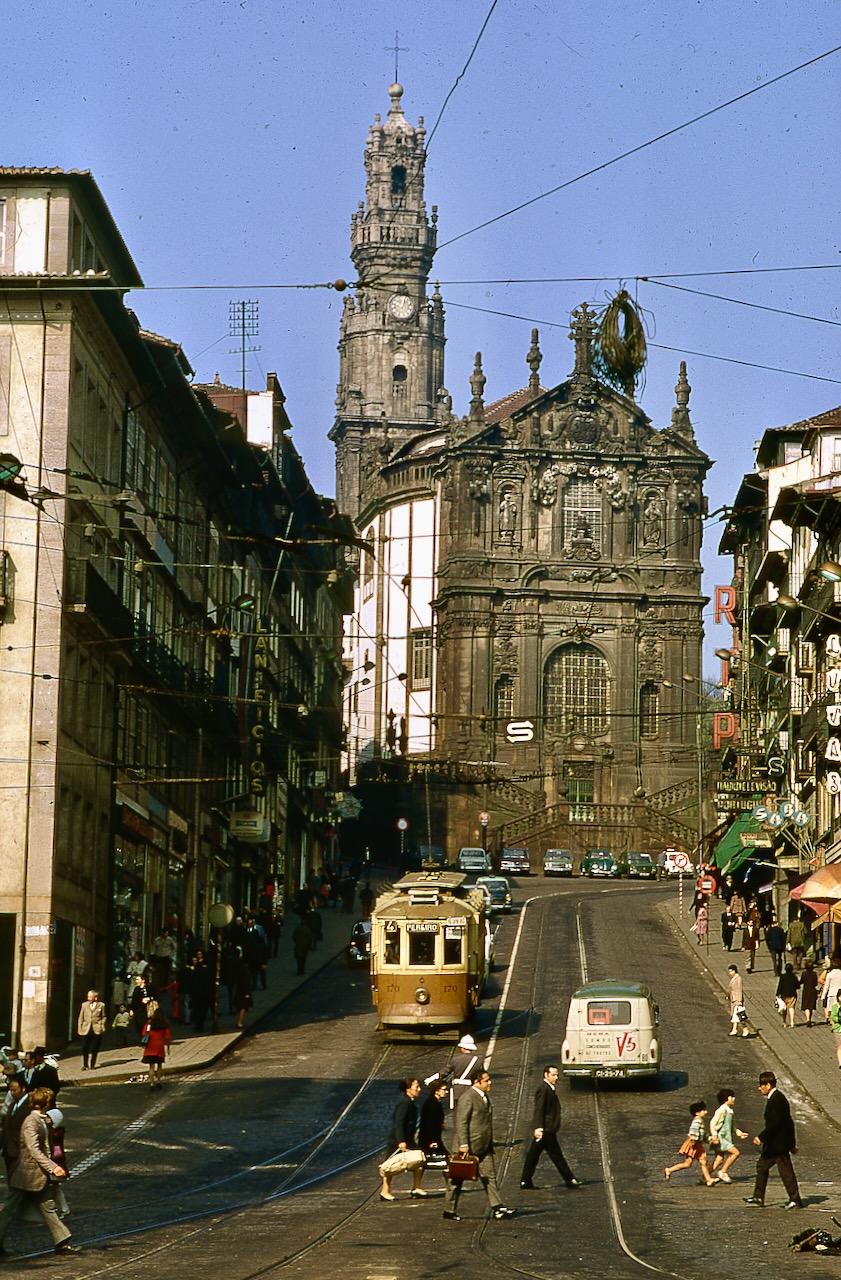
Leave a Reply